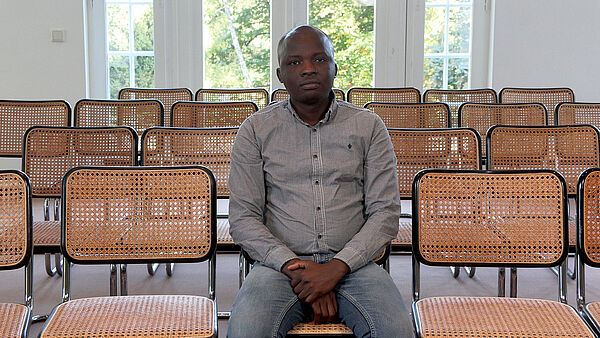
Jerry Ochola, Dr
Senior Lecturer of Industrial and Textile Engineering
Moi University, Eldoret
from September to December 2024
Born in 1982 in Rachuonyo, Kenya
Dr in Materials Engineering from Ghent University
Fellowship
Iso Lomso-Fellow
Project
Computational Modelling of Tubular Fibrous Scaffold Structures for Cardiovascular Graft Applications
The design of tubular structures with desirable internal and external topology is a challenge for engineering cardiovascular grafts. Even though conventional vascular grafts can provide sufficient structural and biological support to tissues, they are expensive and susceptible to anatomical limitations. Hence, fibrous structures such as polymeric electrospun grafts have appeared as viable options for use as cardiovascular implants, due to their suitable extracellular matrix for tissue regeneration, better compliance matching, and improved mechanical properties, even though random fibre assembly is attributed to surface topography, mechanical properties, cell proliferation, and cell growth potential which makes fibrous scaffold structures desirable for use as cardiovascular grafts. These structures still have inherent design limitations due to the random morphology of their microstructure. There is, therefore, a need to investigate and optimise their design and performance. One such approach is the use of computational modelling. However, there is still insufficient information on three-dimensional (3D) computational modelling approaches for tubular fibrous structures that takes into account their constituent fibre alignment and inherent fibre randomness. This project, hence, proposes the use of a realistic 3D modelling approach to develop tubular fibrous scaffold structures. This will involve creating the scaffold models at the nanofibre level in a 3D interface using python® programming and MATLAB® scripting platforms. Further, parametric studies to mimic the biomechanical performance of the scaffold structure models after implantation as vascular grafts will be undertaken by applying realistic boundary conditions based on finite element analysis procedures in ABAQUS®/Explicit. It is envisaged that this modelling approach will provide the basis for an in-depth investigation of the scaffolds’ performance, viability, and reliability, which will further support their seamless integration as cardiovascular grafts.Recommended Reading
Ochola, Jerry, Benny Malengier, Lode Daelemans, John Githaiga, and Lieva Van Langenhove (2018). “Experimental and Numerical Analysis of the Tendon Repair Process Using Tubular Braided Fabrics.” AUTEX Research Journal 18 (2): 121–129. https://doi.org/10.1515/aut-2017-0007.
Ochola, Jerry, Benny Malengier, and Lieva Van Langenhove (2020). “Numerical Investigation of Flexural Bending in Biaxial Braided Structures for Flexor Tendon Repair.” Journal of Biomedical Science and Engineering 13 (6): 93–101. https://doi.org/10.4236/jbise.2020.136009.
– (2022). “Numerical Analysis of Crimping Behaviour of Triaxial Braided Structures.” Journal of Industrial Textiles 51 (4S): 6484S–6502S. https://doi.org/10.1177/15280837211036215.
Colloquium, 13.11.2024
Computational Modelling of Electrospun Vascular Grafts: A Parametric Modelling & FEA Approach
The design of tubular structures with desirable internal and external topology is a challenge for the engineering of ideal grafts for vascular systems. Numerous studies have demonstrated that even though tissue engineered vascular grafts can provide sufficient structural and biological support to blood vessels and organs, they are expensive and susceptible to anatomical limitations. Therefore, polymer-based grafts fabricated by electrospinning have appeared as viable options for use as vascular grafts, due to their suitable extracellular matrix for tissue regeneration, better compliance matching, and improved mechanical properties compared to tissue engineered grafts. However, electrospun vascular grafts in their current form still have inherent design limitations due to inherent morphology of their microstructure as a result of randomly assembled nanofibers that characterise electrospun architecture. In bio-mechanical analysis and performance characterisation of these structures focus has mainly been on planar models of electrospun grafts while ignoring their behaviour in cylindrical form. This in essence implies that there is still need to upscale the modelling of vascular grafts in 3d cylindrical interphase using computational modelling approaches that considers their constituent nanofibre alignment and inherent randomness.
This is the primary aim of this project. In this regard this project develops 3d models of tubular (cylindrical) electrospun vascular grafts based on python® programming platform using numerical python (NumPy) libraries. Different models of the vascular grafts are hence developed by altering crucial parameters such as fiber orientation angle, fiber diameter, and pore size. These attributes are then used to investigate the parameters that have the most influence on the performance of the graft structures in vascular systems either as reinforcements for tissue wall or as replacement for degenerated vascular tissues. An input file for each model is then imported to a computational analysis environment in ABAQUS®/Explicit and ABAQUS/CFD for pre- and post-processing using customised finite element analysis procedures. This is implemented using realistic boundary conditions to mimic the placement, hemodynamics and deformation of the graft models with the aim of investigating and optimising the design of an ideal graft for vascular support and reinforcement. It is envisaged that this approach will provide the basis for an in-depth investigation of electrospun polymer-based grafts’ performance, viability, and reliability, which will advance their seamless integration as vascular grafts.
Publications from the Fellow Library
Ochola, Jerry (Thousand Oaks, Calif. [u.a.], 2022)
Numerical analysis of crimping behaviour of triaxial braided structures
Ochola, Jerry (S.l., 2020)
Numerican investigation of flexural bending in biaxial braided structures for flexor tendon repair
Ochola, Jerry (Warsaw, 2018)
Experimental and numerical analysis of the tendon repair process using tabular braided fabrics
